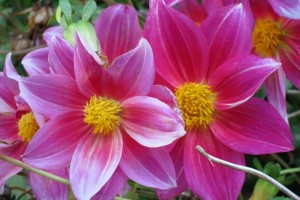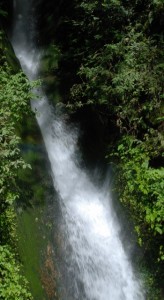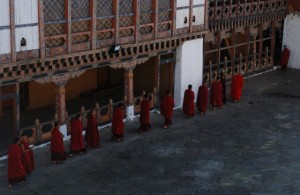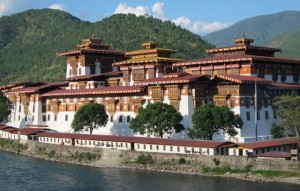 Trongsa Dzong is the second most important dzong in Bhutan. It is an enormous structure. It took eons to build. Currently, it houses about 300 monks. We arrived at the dzong early, just after 8:00 am. Tashi tells us that this is the dzong that he studied in. Everywhere we went we seemed to run into a monk that knows Tashi. After wandering around for a while, we heard a loud slapping sound we learned is the call to the 9 o’clock prayer. Two monks are slapping leather “whips” on the stone and it is quite loud. Monks gather in the courtyard where we are standing. Once all the monks are there, the head monk comes out and leads them single file to another part of the dzong for prayer time. It was special to be able to watch this procession. Again our guide looks brilliant, as we are going out the crowds are on their way in. Score another point Tashi.
Trongsa Dzong is the second most important dzong in Bhutan. It is an enormous structure. It took eons to build. Currently, it houses about 300 monks. We arrived at the dzong early, just after 8:00 am. Tashi tells us that this is the dzong that he studied in. Everywhere we went we seemed to run into a monk that knows Tashi. After wandering around for a while, we heard a loud slapping sound we learned is the call to the 9 o’clock prayer. Two monks are slapping leather “whips” on the stone and it is quite loud. Monks gather in the courtyard where we are standing. Once all the monks are there, the head monk comes out and leads them single file to another part of the dzong for prayer time. It was special to be able to watch this procession. Again our guide looks brilliant, as we are going out the crowds are on their way in. Score another point Tashi.
We headed off and drove for 6 hours toward Punakha.
We have spent numerous hours in the car plying the roads of Bhutan. Every single road is hanging on a cliff. Down these cliffs pours water. Every kilometer there is another waterfall with water gushing from it and across the road. Between the streams are weeping walls that sparkle when the sun shines on them. The rainy season is over, it is fall so the snow has long since melted but the water continues to fall.
 It is little wonder that Bhutan has chosen to build an infrastructure of hydroelectric facilities and export the electricity. The country is adjacent to the two most populated nations in the world and both are starving for power. Personally I look at this with mixed emotions. I understand that if Bhutan wishes to increase its economic wealth it has to find ways to do that, but the cost in terms of changing an unspoiled environment is huge. The fast moving river at the bottom of the gorge, which is quite a spectacular sight, will no longer exist. The land as it exists naturally will once again be transformed by human intervention and not necessarily for the better. The choice for change may be the right one but it is very sad to see a nation that had resisted ‘modern life’ for so long give in to follow a way of living that even those that embrace it know is not the proper direction.
It is little wonder that Bhutan has chosen to build an infrastructure of hydroelectric facilities and export the electricity. The country is adjacent to the two most populated nations in the world and both are starving for power. Personally I look at this with mixed emotions. I understand that if Bhutan wishes to increase its economic wealth it has to find ways to do that, but the cost in terms of changing an unspoiled environment is huge. The fast moving river at the bottom of the gorge, which is quite a spectacular sight, will no longer exist. The land as it exists naturally will once again be transformed by human intervention and not necessarily for the better. The choice for change may be the right one but it is very sad to see a nation that had resisted ‘modern life’ for so long give in to follow a way of living that even those that embrace it know is not the proper direction.
In Punakha we quickly checked into our hotel and were on the road again. We wanted to visit the Punakha Dzong today too.
On October 13, the king (K5) is getting married at the Punakha Dzong. As we approach the dzong we realize it is all decked out in its finery. The only access road is lined with colorful banners, the dzong itself has banners surrounding it, and all the eaves of the immense building have been completely lined with colorful skirting. It looks like a North American house decked out with Christmas lights. You can tell something big is about to go down by the army and police presence. The dirt parking lot was being paved for the occasion. We arrive at the front gate rife with expectation. We are 8 hours too late. The door was shut to foreign visitors this morning. Not even Tashi’s cache could get us by the guard this time. As with people in general here, even the police in Bhutan are polite and a bit reserved, although adamant we would not get in, the fellow seemed a bit embarrassed about the whole situation.
This dzong is the premier dzong in the country and it is too bad we were not able to breach the security to satisfy our self-centered desire to see the place, and I’m sure we would have loved it, but after the number of dzongs we have visited I think I can image its grandeur and will have to suffice with that.
I’m sure there are a few more monasteries and other places of Buddhist significance on our itinerary but I think we have exhausted the inventory of dzongs in western Bhutan. I can’t say I’m sad about that, I am working on a bit of information overload right now and could probably use some time for the knowledge gained to gel.


